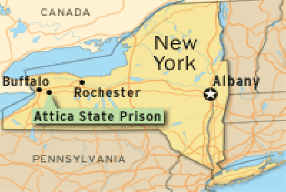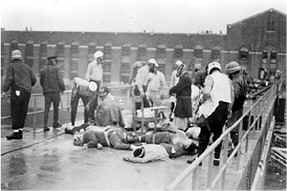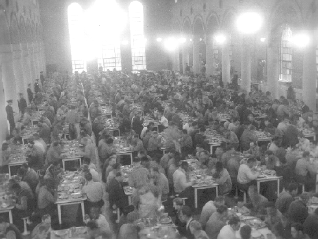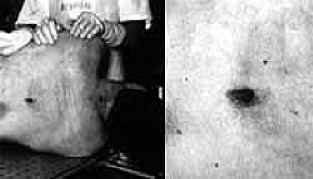|
 |
|

|
It all started on September 9, 1971. It killed 43 people. It
was the bloodiest prison riot in the century. "It".... was
the Attica Prison Rebellion near upstate New York. |
| |
|
  
|
| On
September 9, 1971 around 8:30 AM, the 1300 prisoners in the Attica Prison,
fed up with the poor living facilities, took over the prison taking 40
guards hostage. |

|
| |
|
The
prisoners repeatedly beat the hostages eventually killing one who had
severe injuries, was let go, and then died a couple days later. |
| |
| Negotiations
began to get the hostages and to regain control of the prison. The
prisoner gave a list of demands
for the negotiators to allow and
follow. But only after four days of negotiations, Prison Warden
Russell Oswald and New York governor Nelson Rockefeller ordered the
National Guard to retake the prison. |
| |
| On
September 3, the National Guard retook the prison with a cloud of tear gas
and a series of rapid fire that eventually killed 43 people, 10 of which
were hostages. |

|
| |
| The
prison was retook, but the horrific events still continues.
Prisoners were tortured and beaten afterwards. the National Guard
and the New York Police Department (NYPD) made the prisoners crawl over
broken glass naked. |
| |
| They were
"hosed down" with huge fire hoses and beaten with
nightsticks. One man had a screwdriver repeatedly shoved in his
rectum, while another had to lay in the sun naked for hours with a
football under his chin and was told if he dropped it he would be shot and
killed. |
| |
|
  
|
| Yes,
this rebellion could of been prevented but prison warden Oswald didn't
listen to guards when they told him rumors. He chose to ignore the
warnings and didn't take action. |

|
| |
| This
resulted in the details of many people that could still be alive
today. All the prisoners wanted were better living facilities and to
be treated like actual humans. This statement below by Arthur
Harrison, a former inmate, shows what he thinks of our government.: |
|
"The government didn't admit
it did anything wrong. All the inmates wanted was to be
treated like human beings. Many died for this. The
government didn't want to resolve it peacefully. They wanted
to shoe their strength."
|
|
 |
All of this is true. The government at first even had the nerve to
deny killing the ten hostages saying that the prisoners did it by slashing
their throats, while autopsies later showed untrue by gunshots in the
bodies. |
|
|
The State of New York also denied public access to the riot
and retaking of the prison since 1971 and stated the record shall not open
up again till 2022. |
|
  
|
| Race
had a big impact in this prison. 85% of the prisoners were either
African Americans or Puerto Ricans. They were supposedly in custody
of racist guards who "hated niggers and specs." |
|
|
As you may know, this was the time of the "Black Panthers" so
there were racial tensions everywhere. But in this case, this was
the first time the racial dimension has been prominent. The riot was
supposedly led by a black leader. This was the one good thing
about the riot, that prisoners found that they had each other regardless
of the race or backgrounds they held. |
|
|
  
|
| After
26 years of legal battle with the State of New York, they finally decided
to pay $8 million to the prisoners at the Attica prison for their
suffering. The Judge who with saw the case was U.S. District Court
Judge Michael Telesca who later stated: |
|
"I will not decide who
was right or wrong. I will leave that to history."
|
|
|
And with that the lawsuit ended while correction officers and their
families were never awarded anything other than death benefits or workers
compensation. That is still a legal battle today. |
|
|
|
  
|
| So
after all the years the Attica Prison rebellion came to a close, but the
suffering and inhumane treatment of prisoners still comes to effect
today. They continue to face torture, slave labor, censorship,
inadequate medical care, excessive lockdown, and murder at the hands of
guards. |
|
|
Lets just hope that this does not happen again and maybe the government
will learn that violence does not have to be met by violence so that other
lives will not be lost. |
|
|
| Ashley Shepard
8th American History
Rossville Jr. High
Post-World War II American Project
May 2002 |
Bibliography |


![]()

![]()


![]()

![]()


![]()

![]()
![]()
![]()
![]()
![]()

![]()